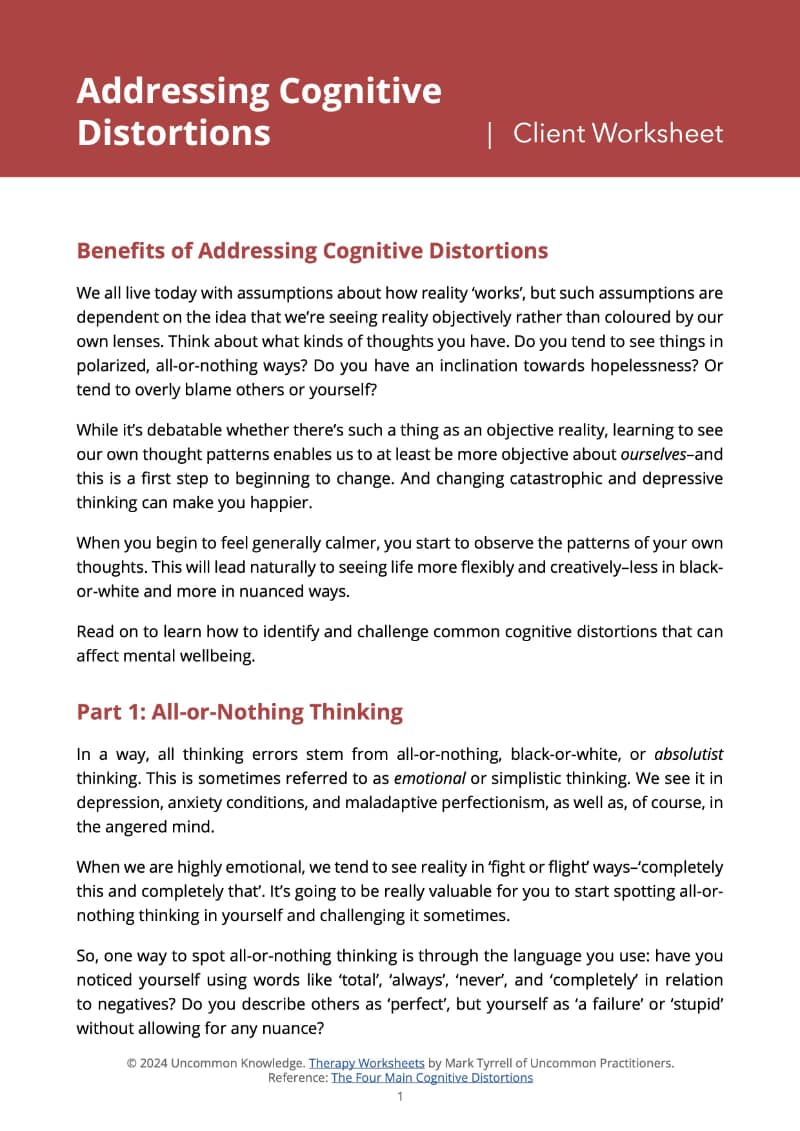
Thinking biases and cognitive distortions skew views of reality
“Except our own thoughts, there is nothing absolutely in our power.”
– Rene Descartes
What kinds of thoughts do you have? Do you tend to see things in polarized, all-or-nothing ways? Do you have an inclination towards hopelessness or tend to overly blame others or yourself?
It used to be assumed that all our emotions were formed by our thoughts. That changing thoughts would be enough to improve our feelings.
But modern therapeutic practitioners understand that many emotional problems result from, and are maintained by, so called faulty pattern matching in the emotional centers of the brain. This process of pattern matching comes prior to conscious thought – or else bypasses it completely.
Once we understand how a pattern in the environment can trigger a pattern within the mind and body without thinking even being involved,1 we can use techniques that help the emotional mind directly. Once we have used calming techniques for, say, PTSD, we will find that because the emotion has changed, the thoughts inevitably change as well.
The emotional brain can, as it were, operate independently from the cognitive mind. But of course, it is still valuable to observe thinking errors, both because they result from excessive emotion and because they can, in turn, lead to it.
So how do we help clients begin to see that their thoughts may be serving them poorly?
Cognitive distortions can only be seen when the mind is still
As long as the pool of water is agitated, the reality reflected from its surface will appear distorted. Only when it calms over can its still reflection give a better approximation of reality. So too with the mind.
Many clients will need to be calm enough before they can see their own thinking biases and cognitive distortions. Sometimes we need to help still the mind in order to help our clients see reality more evenly, in less distorted ways.
This is why psychological practitioners learn how to relax clients using mindfulness and clinical hypnosis – to help the part of the person that is, if you like, outside of thought to observe more directly.
To help our clients see their own thoughts and emotional patterns more clearly, we need to help them expand a sense of their observing self. We can do this both by helping them become calmer and also by directly helping them to see the patterns of their thoughts and the limitations of such thinking.
How to help your client see their cognitive distortions
So, feelings lead to thoughts at least as much as the other way about. But it’s still valuable to help clients understand that their thinking errors are errors, and that they, just like everyone else, see reality not necessarily exactly as it is but rather through the distortions of the emotionally conditioned mind.
When cognitive distortions and thinking errors coalesce into internal patterns about how the world works and who the self and other people fundamentally are, they form a narrative. We construct stories based on ideas of cause and effect that can sometimes be really disempowering.
We call these stories beliefs. Sometimes we are not even really aware of our own emotionally based beliefs. Many of our assumptions as to how reality works lie within the unconscious mind.
So we can help bring a client’s cognitive distortions to consciousness and therefore help them calmly check out their validity. In order to see what their main cognitive distortions are, the client needs to be calm. But, in turn, seeing the limitations of their own thinking can produce greater calm and wellbeing.
So what are the main cognitive distortions and how can we help our clients see them for what they are?
Cognitive distortion one: All-or-nothing thinking
In a way, all thinking errors stem from all-or-nothing, black-or-white, or absolutist thinking. This is sometimes referred to as emotional or simplistic thinking. We see it in depression, anxiety conditions, and maladaptive perfectionism, as well as, of course, in the angered mind.
Reality is seen as either completely this or completely that.
If, for a moment, we view thought as a reflection of feeling, then we can see that the more emotional you become, the closer you get to the all-or-nothing emotional state of the fight-or-flight response.
So if we live with heightened stress, we are more ‘fight or flighty’ and therefore our thinking tends to be more extremist and polarized. When someone is in all-or-nothing mode you will hear them make sweeping overgeneralizations.
Political leaders do the same thing when they want to raise emotion and quell nuanced thought – they may talk in terms of extremely this or absolutely that.
And research into the language of depressed and anxious people has found that someone’s level of absolutist language correlates with their likelihood of contemplating or attempting suicide.2
Examples of all-or-nothing thinking are:
- “Nothing ever works for me!”
- “You always let me down!”
- “My life is completely ruined!
- “I have to be absolutely perfect!”
How we can help
We can help clients relax in order to move further from the fight-or-flight state, and also explain to them how all-or-nothing thinking operates and how to spot and challenge it.
FREE Cognitive Distortions Worksheet
Use this worksheet to help your clients break down unhealthy thought patterns and replace them with more constructive ones. I’ll also send you my weekly Clear Thinking newsletter with actionable therapy tips.
Cognitive distortion two: Overgeneralization
Sometimes known as globalizing, overgeneralization is really a specific type of all-or-nothing thinking error.
Examples of overgeneralizations are:
- “I failed that test; I must be completely stupid!”
- “The relationship ended; I ruin everything!”
- “She wouldn’t go out with me; no one would!”
How we can help
We can help clients by gently challenging these blanket ideas and helping them find exemptions. We can do this (as with all the cognitive distortions) through gentle Socratic questioning.
Cognitive distortion three: Internalizing and externalizing
You guessed it – this, too, is really just another manifestation of the all-or-nothing thinking error. Overly internalizing people may see themselves as assuming all or most of the blame when really it’s more than their fair share.
Examples of internalizing are:
- “The party wasn’t a great success; I guess I just can’t make people happy!”
- “I get upset when he’s in a bad mood because it must be something I’ve done!”
- “I feel it’s my fault we lost that soccer match!”
Internalizing isn’t about just accepting responsibility but rather assuming blame or total causation for things not working out. On the other hand, blaming others excessively – externalizing – is a way of handing over power and therefore increases a sense of helplessness.
It’s not at all uncommon to find that someone alternates between both excessive internalizing and excessive externalizing.
How we can help
I’ve written about the dangers of excessive externalizing and what we can do about it here.
Cognitive distortion four: Stabilizing the negative, destabilizing the positive
A thinking error that is connected to hopelessness – which seems to be common in depression – is stabilizing the negative. Assuming things will always be bad knocks out that all-important sense of hope.
Clients who stabilize the negative feel that everything will always be, and perhaps has always been, bad.
Examples of stabilizing are:
- “I’ll never be any good!”
- “No one could ever love me!”
- “Nothing has ever gone right for me!”
Positives may be accepted but are, unlike negatives, seen as fragile and likely to change: “Yes, the relationship is working now, but what worries me is that it’s too good to last!”
How we can help
Rather than directly clash with our clients’ cognitive distortions, which are, after all, belief systems, we can gently ask the kind of questions that can subtly imply hope.
The above are the main kinds of cognitive distortions, caused perhaps in part by being ‘infected’ by other people using these biases,3 as well as by other forms of emotional conditioning.
Other common cognitive distortions
The following are subsets of the above cognitive distortions.
- Catastrophizing: Believing the worst possible outcome is the only likely one. I have written specifically about how to stop clients catastrophizing here.
- Magnification and minimization: Inflating the importance of unfortunate or negatively perceived events or situations while ignoring or minimizing positive situations, events, or aspects of the self. Achievements are seen as unimportant, but any mistakes seen as massively important.
- Magical thinking: An irrational sense of cause and effect. “I got ill recently because I left my first husband 30 years ago!” or “If I wash my hands a hundred times my wife will remain safe.”
- Unfounded conclusions: Jumping to conclusions with little or no evidence. “If I don’t do this perfectly I must be really stupid!” or “I didn’t go to college. How can I ever be a success!”
- Mind reading: A type of unfounded conclusion based on feeling but not calm observation or evidence. The mind reader will assume the thoughts and feelings of others and the feeling will convince them that they are right. “He thinks I’m stupid!” or “You must think I’m a bad person!”
- Outdated thinking: Feeling that life will continue along a similar trajectory to the past even though the situation has changed. A person may still feel and believe that they are likely to be cast out on the streets even though they have now acquired wealth, or that because a previous lover cheated on and finally abandoned them that their current and decent partner will surely do the same. These thoughts track along with learned helplessness.
- Musterbation: The thinking error that life should have strict self-imposed rules. You’ll often hear the musterbator say things like “I should be more patient with that bully at work!” Or “I shouldn’t feel like this!” Or “If he loved me, he wouldn’t/would…”
As you can see, all of these have an element of all-or-nothing or emotional thinking to them.
It might sound strange, but in a way we need to help our clients be less sure of themselves when it comes to limiting beliefs. Starting to doubt self-doubting ideas is the beginning of personal growth.
Be subtle when you challenge limiting beliefs
Rather than argue with our clients’ limited perspectives and risk losing rapport with them, we can recognize their limiting beliefs without pointing them out directly. After all, the backfire effect can be strong with those who have been using negative biases for a long time.
We can interject when we spot a limiting belief, with statements like “That’s an interesting idea” or “Yes, I had another client who thought that” or “That could be true”, or even just “Maybe” followed by a quick change in subject. This breaks down rigid thinking without denying the person’s interpretation.
When we help our clients feel better and tame the jagged, self-lacerating edges of their thought, a strange thing happens.
Seeing the shades of grey
When we help our clients be calm and start to observe the patterns of their own thoughts, they will naturally see more flexibly and creatively, in less black-and-white and more nuanced ways.
When thoughts can be seen and challenged and emotional calm increases generally, our clients will no longer have to assign meaning to events prematurely before real evidence emerges.
We call this being able to hold a meaning vacuum – being able to relax with not knowing and tolerate uncertainty and ambiguity effectively.
As Aristotle once said: “It’s the mark of an educated [I might add healthy] mind to be able to entertain a thought without accepting it.”
For more on freeing clients from limiting beliefs, check out our online course on the art of Conversational Reframing, where you can also sign up to be notified when the course is open for booking.
Notes:







